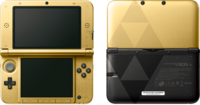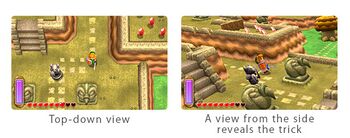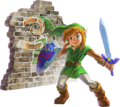The Legend of Zelda: A Link Between Worlds
This article has been flagged since December 2013.
The Legend of Zelda: A Link Between Worlds is the seventeenth original Zelda game. It is the first Zelda title developed specifically for the Nintendo 3DS.
A Link Between Worlds is an indirect sequel to Template:ALTTP. It features a similar overworld, gameplay, and music. The title thus marks a deliberate return to the series' 2D roots.
The game was released on November 22, 2013 in North America and Europe, and on November 24 in Australia. It will be released on December 26 in Japan.
Story
Template:Sectstub Hyrule has enjoyed centuries of peace and prosperity since Ganon was sealed by Link and the Seven Sages sometime after the events of Link's Awakening.
After having a nightmare involving facing down a dark, shadowy figure, Link awakens to the sound of Gulley, the Blacksmith's son, calling for him. Having overslept again and shirked his responsibility to his master, Link follows Gulley to the Blacksmith's shop where he runs into the departing Captain. As the Captain thanks the Blacksmith for his new shield and departs, the Blacksmith's Wife quickly realizes that the absent-minded Captain has forgotten his sword and tasks Link with returning it to him. A guard at Hyrule Castle's front gate reveals to Link that the Captain intended on visiting the Sanctuary before returning to his duties.
As Link arrives at the Sanctuary, he walks in on a conversation between the Priest's daughter, Seres, and the gravedigger, Dampé. Seres offers to retrieve the Captain from inside as Dampé continues speaking to Link, before the doors to the Sanctuary slam shut and Seres screams in terror. Dampé informs Link of a secret passage into the Sanctuary beneath one of the graves, and urges Link to use the Captain's sword to navigate the passage and rescue those inside. As Link arrives, he witnesses a strange sorcerer by the name of Yuga casting a spell on Seres to transform her into a painting. The Captain - having failed to defend the Priest and Seres - met with a similar fate on the Sanctuary's wall. As Link charges to confront Yuga, the sorcerer transforms into a painting himself, yet retains his mobility. Link loses consciousness after hitting the wall, and Yuga escapes with Seres' portrait in tow.
Link awakens in his house once more, this time with a strange person in a rabbit hood greeting him as he regains consciousness. The person introduces himself as the merchant Ravio. After learning what happened to Link and asking permission to stay in his house a while, Ravio gifts him with an old, musty bracelet and suggests Link report the happenings to Princess Zelda so something can be done about it. At the gate, a guard laughs at Link's story and gains the attention of Impa, Princess Zelda's attendant. Impa allows Link entry into the castle as she announces Link's arrival to the Princess.
Princess Zelda quickly recognizes Link from her dreams, and gives him the Pendant of Courage - something Link at the time believes to be a simple good-luck charm - and tasks him with finding the elder of Kakariko Village, Sahasrahla.
Gameplay

Overview
A Link Between Worlds uses traditional 2D gameplay as featured in the early Zelda games, unlike the Nintendo DS games (Phantom Hourglass and Spirit Tracks), which used an unorthodox touch-screen control system, and the 3D games, which started with Ocarina of Time.
The top screen shows the main game, while the bottom one shows the map, Rupee count, item buttons (X and Y), and a button labeled "Collect," which allows players to access a twenty-slot inventory. The touch screen is comparable to that of Ocarina of Time 3D. The A button controls basic actions like transforming, the B button is dedicated to the sword, and X and Y use items. The 3D capabilities of the console enhance gameplay in several ways. For example, some dungeons allow the player to see below beyond the current floor they are on. An Energy Gauge that regenerates over time also appears, this time used for every item in the game, even replacing collectible bombs and arrows.
Item Renting
A Link Between Worlds is non-linear compared to other recent Zelda games, almost to the extent of the original Template:LoZ, allowing Link freedom in choosing dungeons or areas to explore. This was accomplished with a new item rental system, which allows Link to temporarily use any item in the game, provided he has enough Rupees.
Item renting is done through Ravio's shop, which carries all key items- they are no longer found in dungeons. Link can either rent or buy items, the difference being that renting is temporary and costs fewer Rupees. If Link loses all of his hearts while renting items, they will be taken from him and returned to the shop, forcing him to trek all the way back to re-rent them. This was a conscious decision on the part of the developers to make the game more challenging. Purchasing items, on the other hand, is far more expensive, but allows Link to keep the items and also allows him to upgrade them with Mother Maiamai.
Becoming a Drawing
A major new ability in the game, tied to both the gameplay and the plot, is the ability for Link to transform himself into a drawing. This ability is used to cling to (and move along) walls, fit through tight crevices, and access Lorule[1][2], among other functions, allowing it to be an integral part of puzzles. Other characters in the game, such as the Sages, also become drawings in a similar fashion as a plot device. This ability depletes the Stamina meter, so it cannot be used indefinitely. Link resembles a hieroglyphic sketch in this mode, as do others who have been transformed.
Game Information
Development
Confirmed by Eiji Aonuma on November 3, 2011,[3] this new installment takes elements from previous console Zelda games. Aonuma also stated that it is not a direct sequel to any of the other titles released on the Nintendo DS.[4] Shigeru Miyamoto publicly stated he wished to create something "new, based on, or starting from" A Link to the Past in an April 2012 interview.[5] The game was officially revealed on April 17, 2013 during a Nintendo Direct.[6][7] A playable demo was made available to the press shortly afterwards, showcasing the dungeon from the trailer.
Upon the game's release, an official Iwata's Ask feature was released, an interview conducted by Satoru Iwata to the game's developers, regarding the game's conception and creation. They revealed that the project involved a rocky development cycle, being put on hold after various members of the team were drafted to other 3DS/Wii U projects. At first, the game was meant to be a sequel to the Nintendo DS games, and a prototype was made in 2010 that featured the same cel-shaded Link as seen in Spirit Tracks, with a simple flattening ability that allowed Link to blend into the wall.
This prototype approved by Shigeru Miyamoto (who had dismissed previous ideas for the game as "20 years old"), the team was ready to develop the game, but they were drafted to various Wii U titles and Skyward Sword; the team effectively disbanded. Aonuma quietly resumed work on the game along with a few other people before the rest of the team began returning. Miyamoto then proposed that the game be based directly on Template:ALTTP, and development started "in earnest". Elements that the team focused on were achieving a framerate of 60FPS, which allowed the action on-screen to flow smoother and also allow drag-and-drop item rearrangement on the Touch Screen, use of stereoscopic 3D, and new gameplay elements that built on A Link to the Past.
Timeline Placement
A Link Between Worlds is an indirect follow-up to A Link to the Past and its direct sequels, set in the same world as the SNES classic, but features a new storyline and new dungeons. In various interviews, Eiji Aonuma said that the game shows what happened to characters from A Link to the Past after the events of that game,[8] but features different incarnations of Link and Zelda than those of A Link to the Past.[9] The Hero and Princess of A Link to the Past are mentioned repeatedly, and their story is even narrated through a series of paintings in Hyrule Castle.
A Link Between Worlds takes place centuries after the events of Link's Awakening but before Template:LoZ in the "Downfall" split timeline after Ganon successfully defeated Link in Ocarina of Time. It features different incarnations of Link and Zelda,[10] including the descendants of most the characters from Ocarina of Time and A Link to the Past, such as the sages.
The final cutscene of the game reveals that it is most likely set immediately before Hyrule's Golden Age, which was when the Royal Family of Hyrule gained possession of the unified Triforce, and peace ruled the land. The main story of the game ultimately concerns how all three parts of the Triforce were unified and enshrined again in the Sacred Realm. The game ends with Link and Zelda touching the Triforce together and wishing Lorule, along with its own Triforce, be restored to its former state. Both worlds are restored to lasting peace, having learned to respect the power of the Triforce.
Setting
A Link Between Worlds takes place in both Hyrule from A Link to the Past and an alternate, corrupted version of Hyrule, called Lorule.[11] Lorule once housed a counterpart to the Triforce of Hyrule[12], with similar powers and history. However, wars were fought over Lorule's Triforce, and the people ultimatly destroyed it, resulting in Lorule's corruption. As a direct counterpart to Hyrule, Lorule features many counterparts to Hyrule's citizens, like Princess Hilda to Princess Zelda.
Audio
The game features re-arranged music from A Link to the Past.[13] The sound effects are also carried over from A Link to the Past. In addition to this, the "StreetPass Battle Theme" and "StreetPass Victory Theme", are rearrangements of the famous "Temple Theme" from The Adventure of Link, marking only the second time that a music theme from that game has appeared in a subsequent Zelda game (the first was in The Minish Cap when Zelda awoke and during battles with Darknuts). This is because in StreetPass mode, the player is Link and the opponent is 'Shadow' Link, inspired by the controversial final boss fight from The Adventure Of Link.[14]
Completion Records
| Time | Performer | Date | Notes |
|---|
Nintendo 3DS XL Limited Edition

A special limited edition 3DS bundle was also released, including a gold and black Zelda-themed console emblazoned with the Triforce on the top and bottom, and an eShop code to download the digital version of the game. It was released at retail price of $219.99 in the United States.[15]
Listings
Characters
Bosses
Enemies
Dungeons
Places
Items
Translations
Credits
Glitches
Trivia

- While experimenting with a strict top-down view with 3D graphics, the team ran into a unique issue: the game "looked boring" because only the tops of characters' heads and buildings could be seen. In order to emulate the older, 2D, pseudo-3D graphics, all non-environmental models are skewed in their placement, to slightly face up at the camera.
- A Link Between Worlds's Hero Mode is the only one in the series to include recovery hearts.
- This is the first Zelda game where the highlighted text is blue rather than the traditional red.
Gallery
Box Art
-
North America
3DS XL Bundle
-
North America
-
Europe
Illustrations
-
The Master Sword, deep within the Lost Woods
-
Link and Yuga fighting
-
Link in Hyrule Castle
Prologue
-
The war over the Triforce
-
The Seven Sages seal the Triforce in the Sacred Realm
-
Ganon captures the Princess Zelda of A Link to the Past
-
The Link of A Link to the Past slays Ganon
-
The Triforce separates
Artwork
-
Pre-release artwork revealed during E3 2013
-
Link and his painting form
-
Princess Zelda trapped in a painting
-
Hyrule and Lorule's parallel Triforces
Press Screenshots
Nintendo Direct (August 7, 2013)
-
The first screenshot of Lorule
-
Link fighting Tarosu
-
Link escaping from Tarosu through a crack in the world
-
Link talking to Sahasrahla
-
A comparison screenshot of Hyrule and Lorule
-
Link in Ravio's shop revealed by Eiji Aonuma on Miiverse
E3 2013
-
Link as a drawing and a blue Tektite
-
Link escaping some Terrorpins
-
Link fighting a Zora
-
Link standing outside his house
-
The entrance to the Eastern Palace
-
Link fighting many Stalfos
-
Link fighting an Octorok
-
Link fighting a Moldorm
-
Link fighting Tektites
-
Link using his Hammer on Terrorpins
Nintendo Direct (April 17, 2013)
-
Link fighting Buzz Blobs
-
Link being launched into the air
-
Link using a Sword Beam on Stalfos
-
Link fighting a big Moldorm boss
-
Link becoming a drawing
Video Gallery
| Language | Name | Meaning | |
|---|---|---|---|
| Japanese | Template:Japanese | The Legend of Zelda: Triforce of the Gods 2 | |
| Spanish | The Legend of Zelda: A Link Between Worlds | ||
- ↑ Template:Cite web
- ↑ Template:Cite web
- ↑ Template:Cite web
- ↑ Template:Cite person
- ↑ Template:Cite person
- ↑ Template:Cite web
- ↑ Template:Cite web
- ↑ Template:Cite person
- ↑ Template:Cite person
- ↑ Template:Cite web
- ↑ Template:Cite person
- ↑ Template:Cite person
- ↑ Template:Cite person
- ↑ Template:Cite web
- ↑ Nintendo 3DS catalog, Nintendo.com.




























